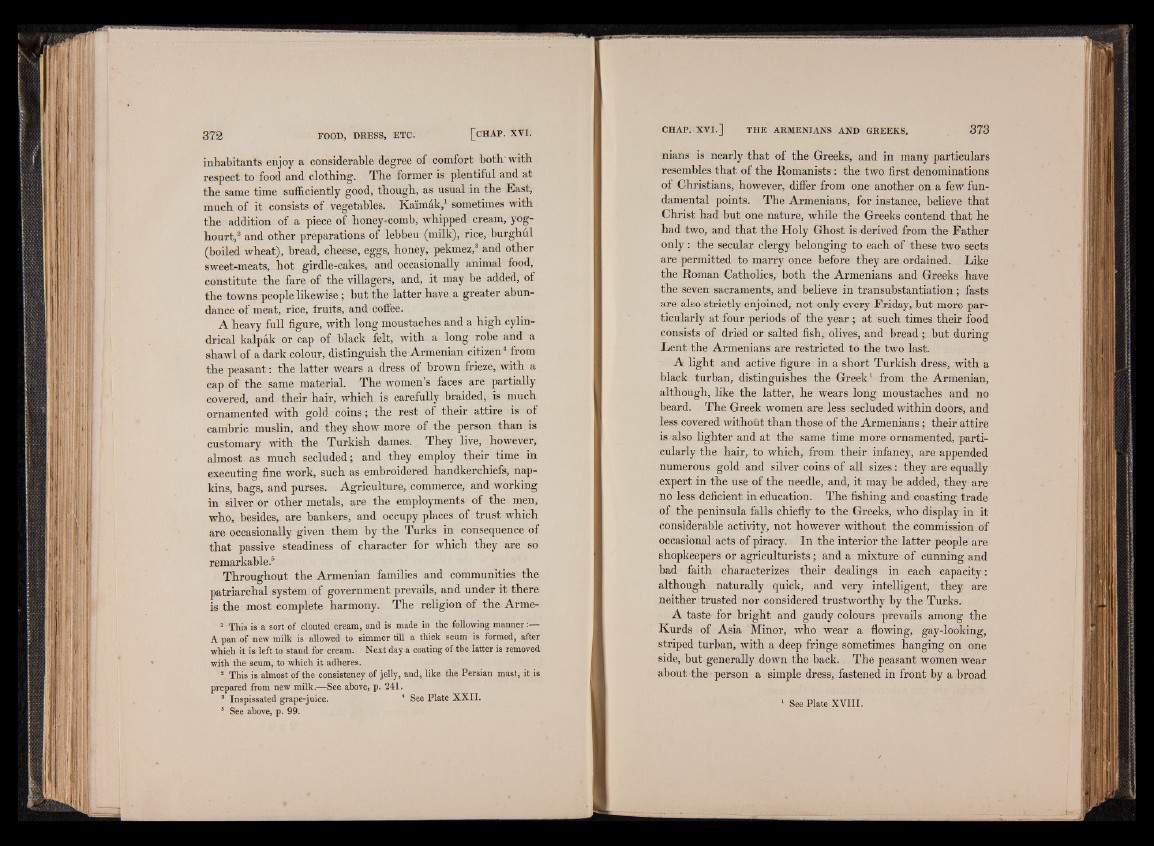
inhabitants enjoy a considerable degree of comfort both with
respect to food and clothing. The former is plentiful and at
the same time sufficiently good, though, as usual in the East,
much of it consists of vegetables. Kairnak,1 sometimes with
the addition of a piece of honey-comb, whipped cream, yog-
hourt,2 and other preparations of lebbeu (milk), rice, burghul
(boiled wheat), bread, cheese, eggs, honey, pekmez,3 and other
sweet-meats, hot girdle-cakes, and occasionally animal food,
constitute the fare of the villagers, and, it may be added, of
the towns people likewise; but the latter have a greater abundance
of meat, rice, fruits, and coffee.
A heavy full figure, with long moustaches and a high cylindrical
kalpak or cap of black felt, with a long robe and a
shawl of a dark colour, distinguish the Armenian citizen4 from
the peasant: the latter wears a dress of brown frieze, with a
cap of the same material. The women’s faces are partially
eovered, and their hair, which is carefully braided, is much
ornamented with gold coins; the rest of their attire is of
cambric muslin, and they show more of the person than is
eustomary with the Turkish dames. They live, however,
almost as much secluded; and they employ their time in
executing fine work, such as embroidered handkerchiefs, napkins,
bags, and purses. Agriculture, commerce, and working
in silver or other metals, are the employments of the men,
who, besides, are bankers, and occupy places of trust which
are occasionally given them by the Turks in consequence of
that passive steadiness of character for which they are so
remarkable.6
Throughout the Armenian families and communities the
patriarchal system of government prevails, and under it there
is the most complete harmony. The religion of the Arme-
1 This is a sort of clouted cream, and is made in the following manner:—
A pan of new milk is allowed to simmer till a thick scum is formed, after
which it is left to stand for cream. Next day a coating of the latter is removed
with the scum, to which it adheres.
2 This is almost of the consistency of jelly, and, like the Persian mastj it is
prepared from new milk.—See above, p. 241.
8 Inspissated grape-juice. 4 See Plate XXII.
5 See above, p. 99.
nians is nearly that of the Greeks, and in many particulars
resembles that of the Romanists: the two first denominations
of Christians, however, differ from one another on a few fundamental
points. The Armenians, for instance, believe that
Christ had but one nature, while the Greeks contend that he
had two, and that the Holy Ghost is derived from the Father
only : the secular clergy belonging to each of these two sects
are permitted to marry once before they are ordained. Like
the Roman Catholics, both the Armenians and Greeks have
the seven sacraments, and believe in transubstantiation; fasts
are also strictly enjoined, not only every Friday,but more particularly
at four periods of the year; at such times their food
consists of dried or salted fish, olives, and bread ; but during
Lent the Armenians are restricted to the two last.
A light and active figure in a short Turkish dress, with a
black turban, distinguishes the Greek1 from the Armenian,
although, like the latter, he wears long moustaches and no
beard. The Greek women are less secluded within doors, and
less covered without than those of the Armenians; their attire
is also lighter and at the same time more ornamented, particularly
the hair, to which, from their infancy, are appended
numerous gold and silver coins of all sizes: they are equally
expert in the use of the needle, and, it may be added, they are
no less deficient in education. The fishing and coasting trade
of the peninsula falls chiefly to the Greeks, who display in it
considerable activity, not however without the commission of
occasional acts of piracy. In the interior the. latter people are
shopkeepers or agriculturists; and a mixture of cunning and
bad faith characterizes their dealings in each capacity:
although naturally quick, and very intelligent, they are
neither trusted nor considered trustworthy by the Turks.
A taste- for bright and gaudy colours prevails among the
Kurds of Asia Minor, who wear a flowing, gay-looking,
striped turban, with a deep fringe sometimes hanging on one
side, but generally down the back. The peasant women wear
about the person a simple dress, fastened in front by a broad
1 See Plate XVIII.